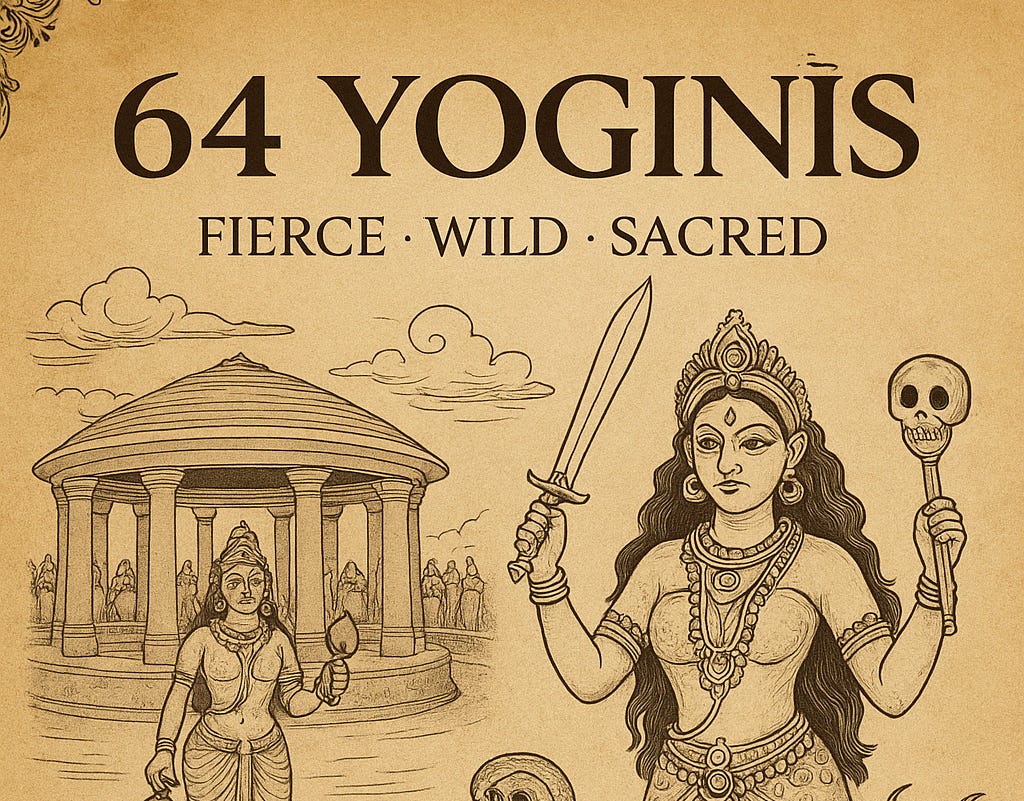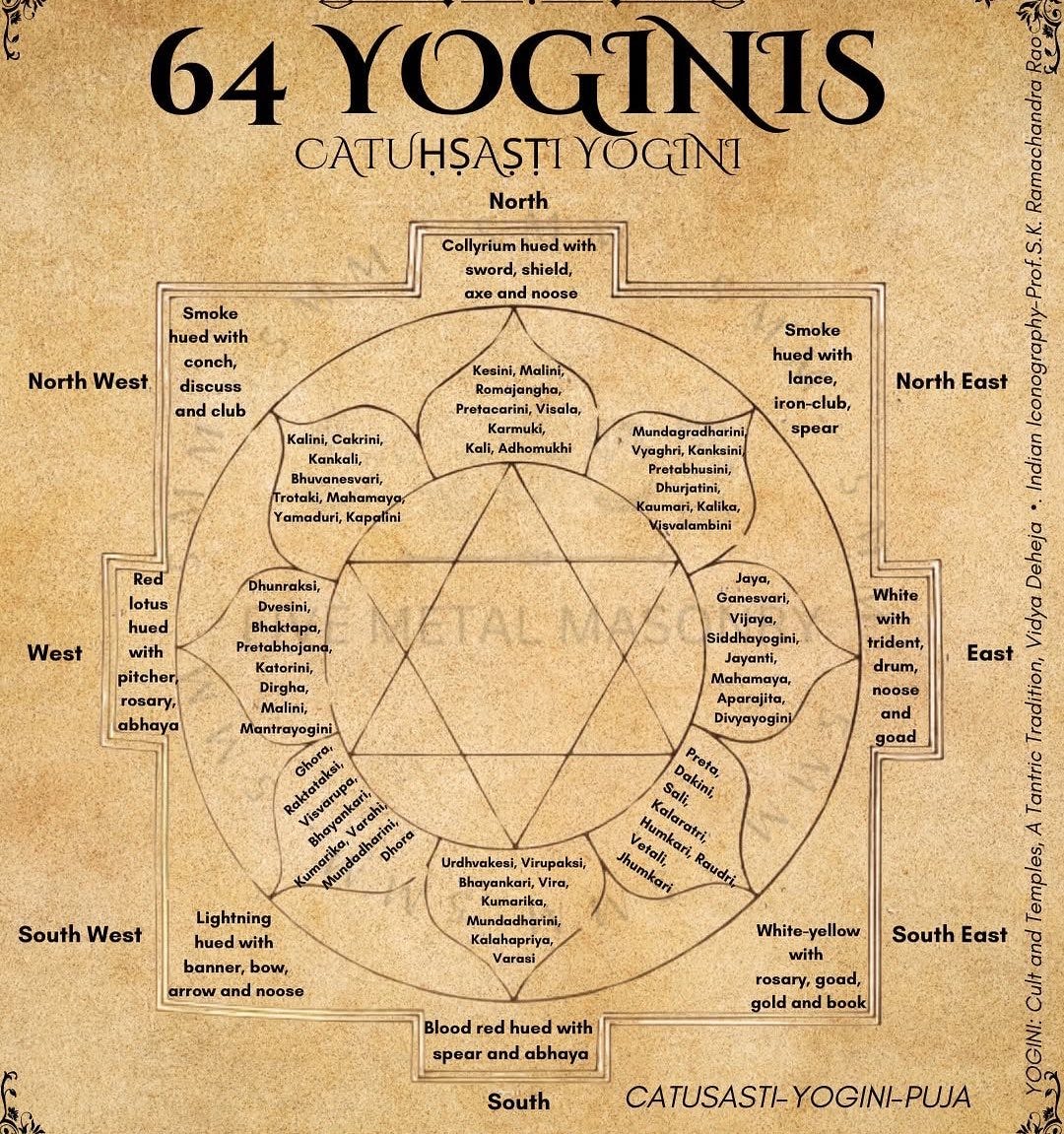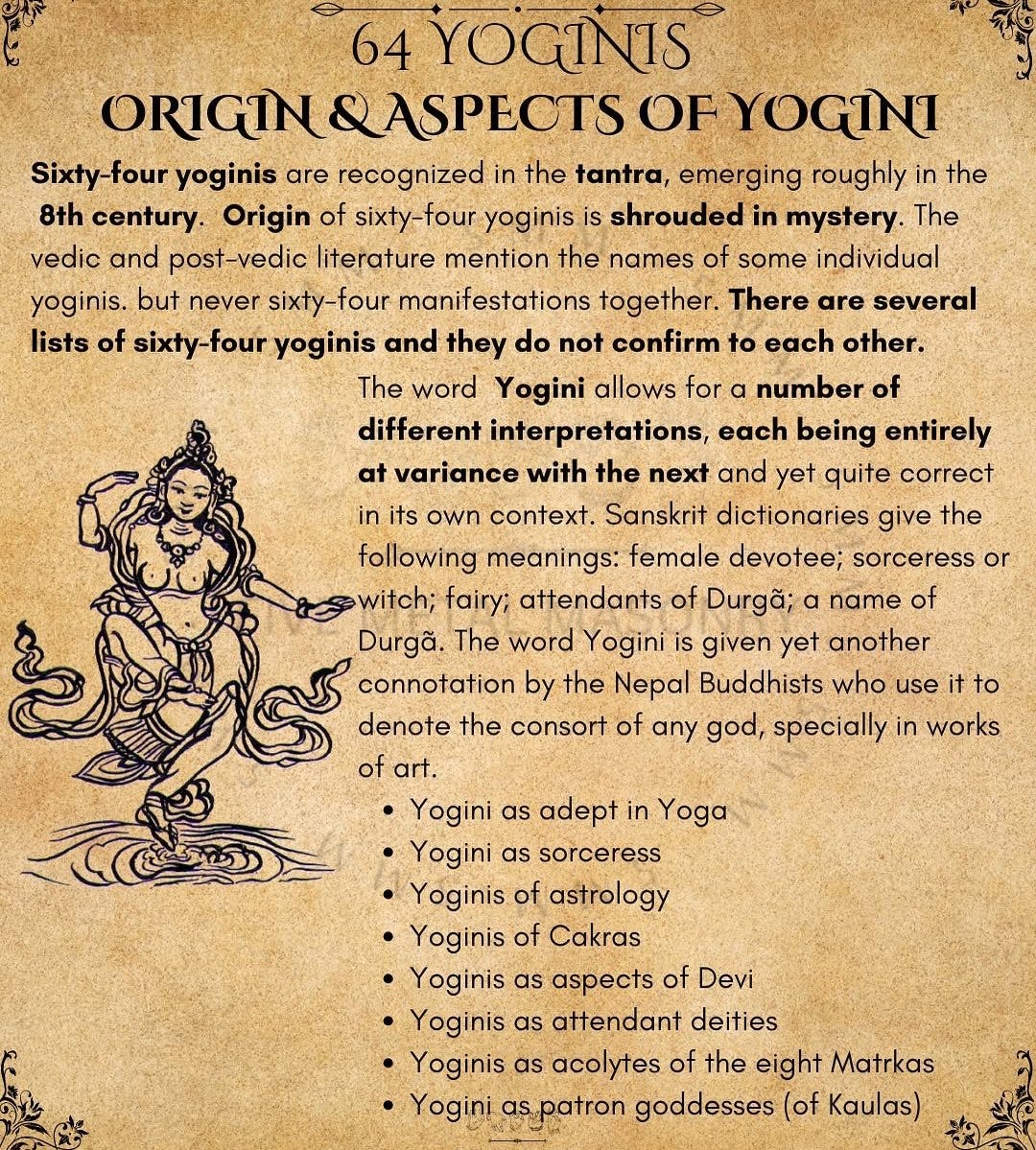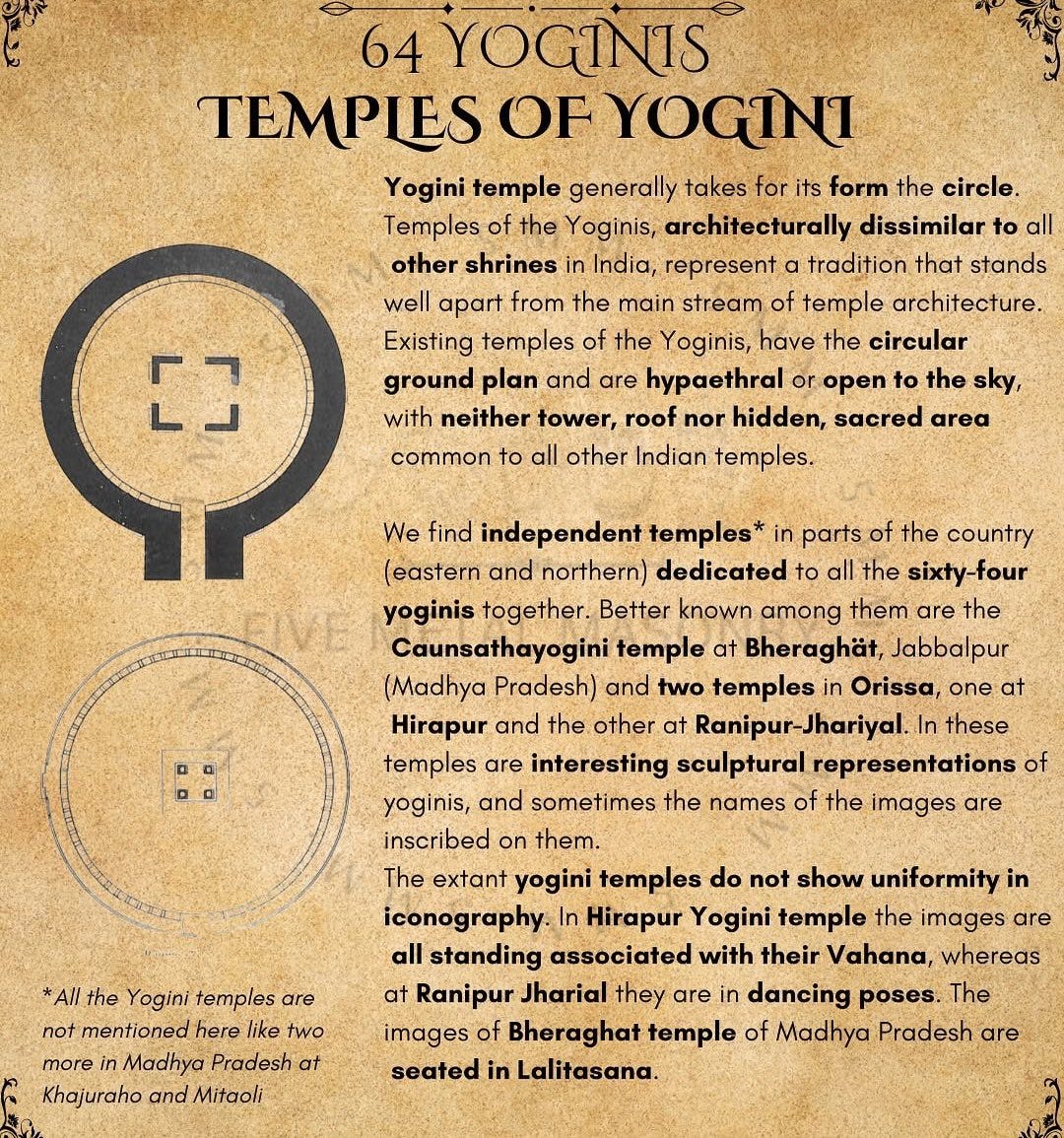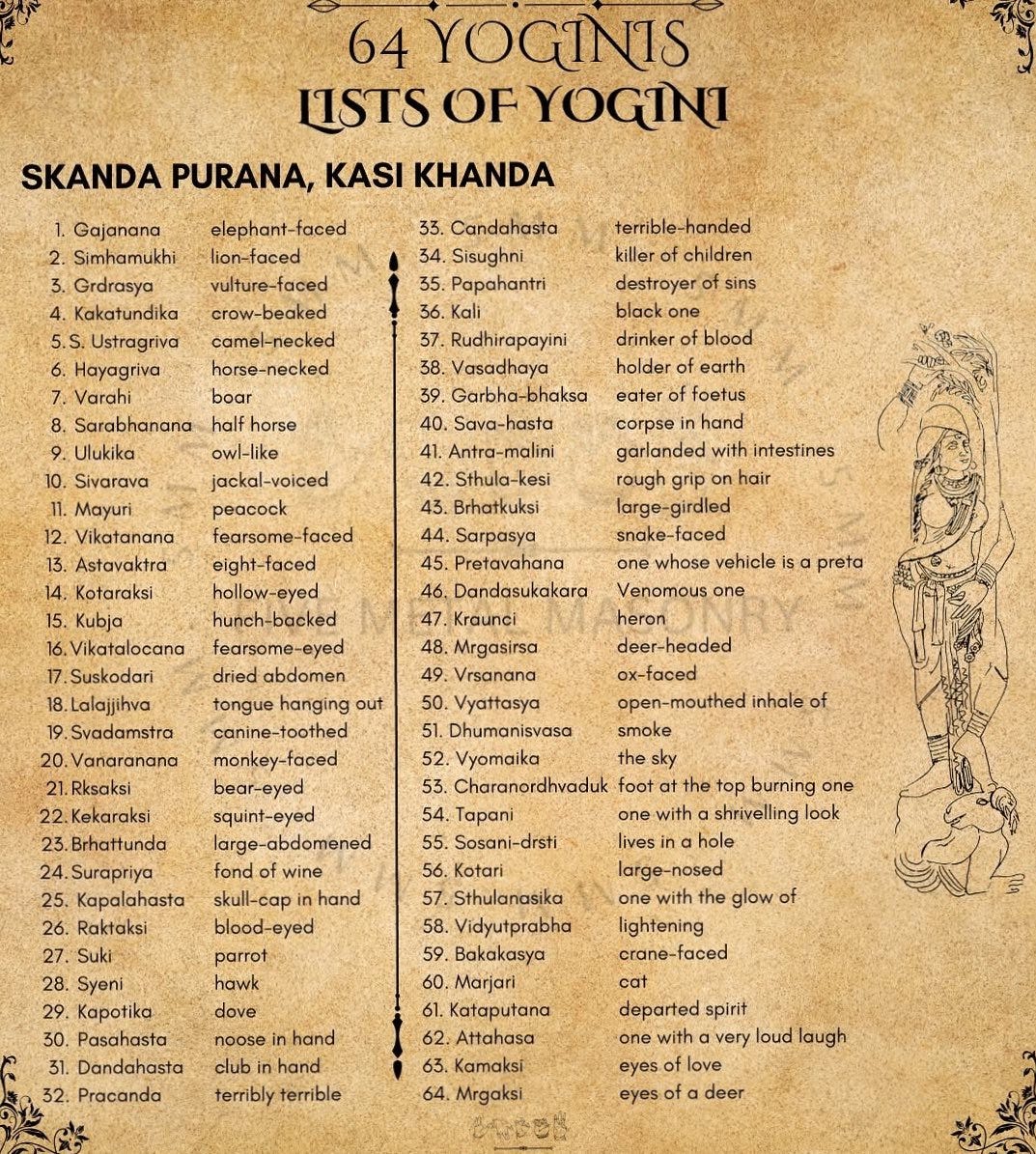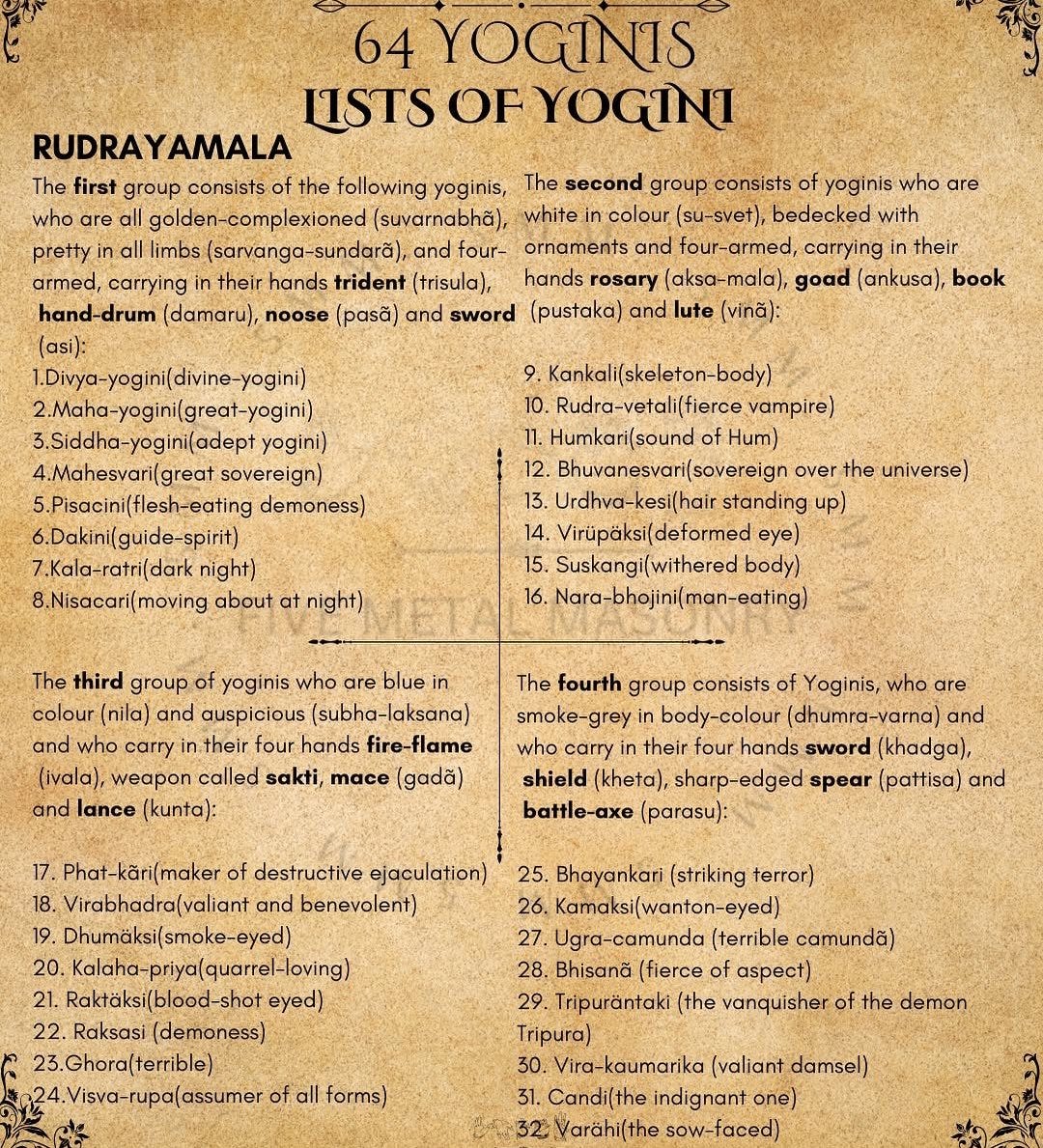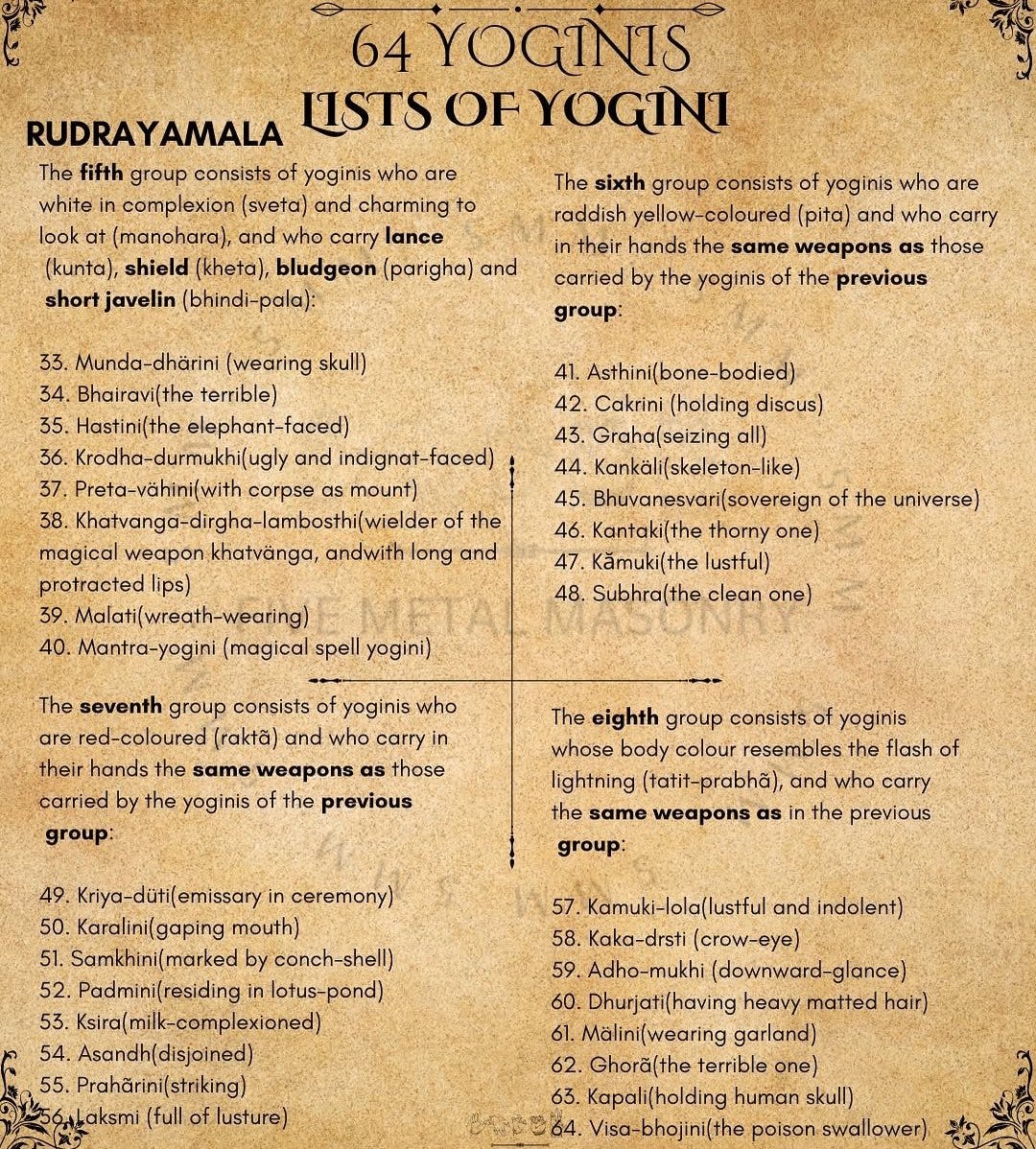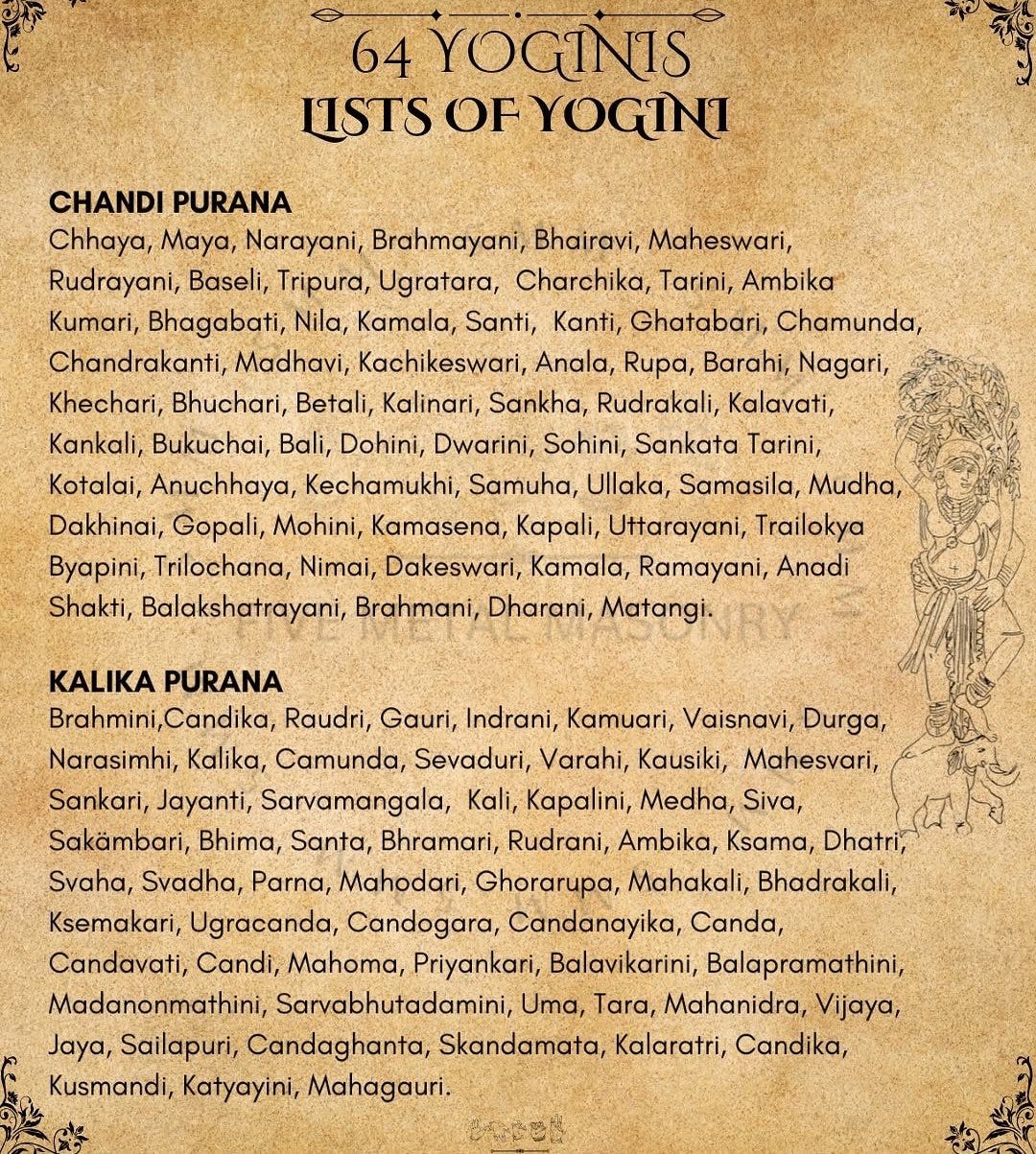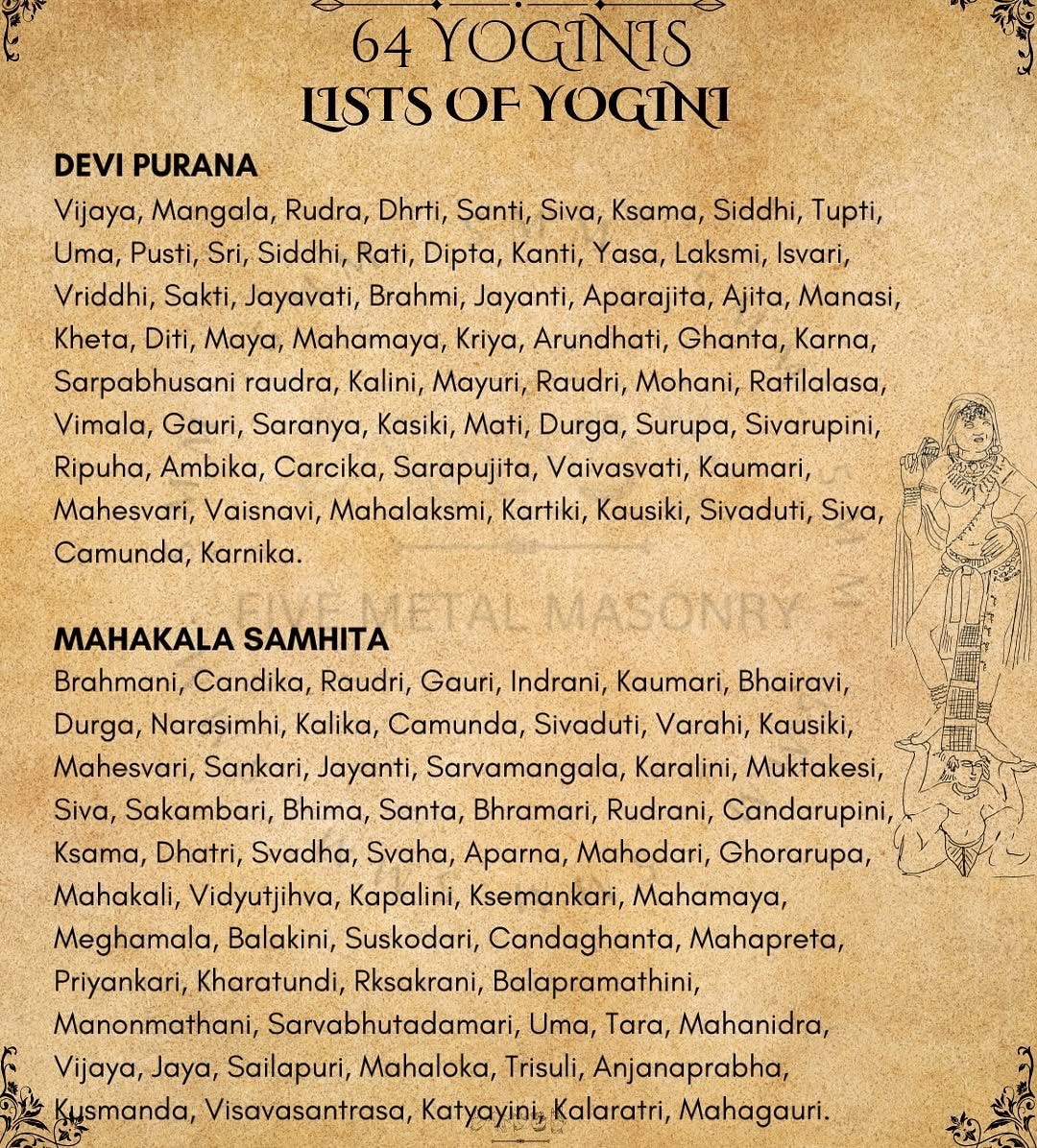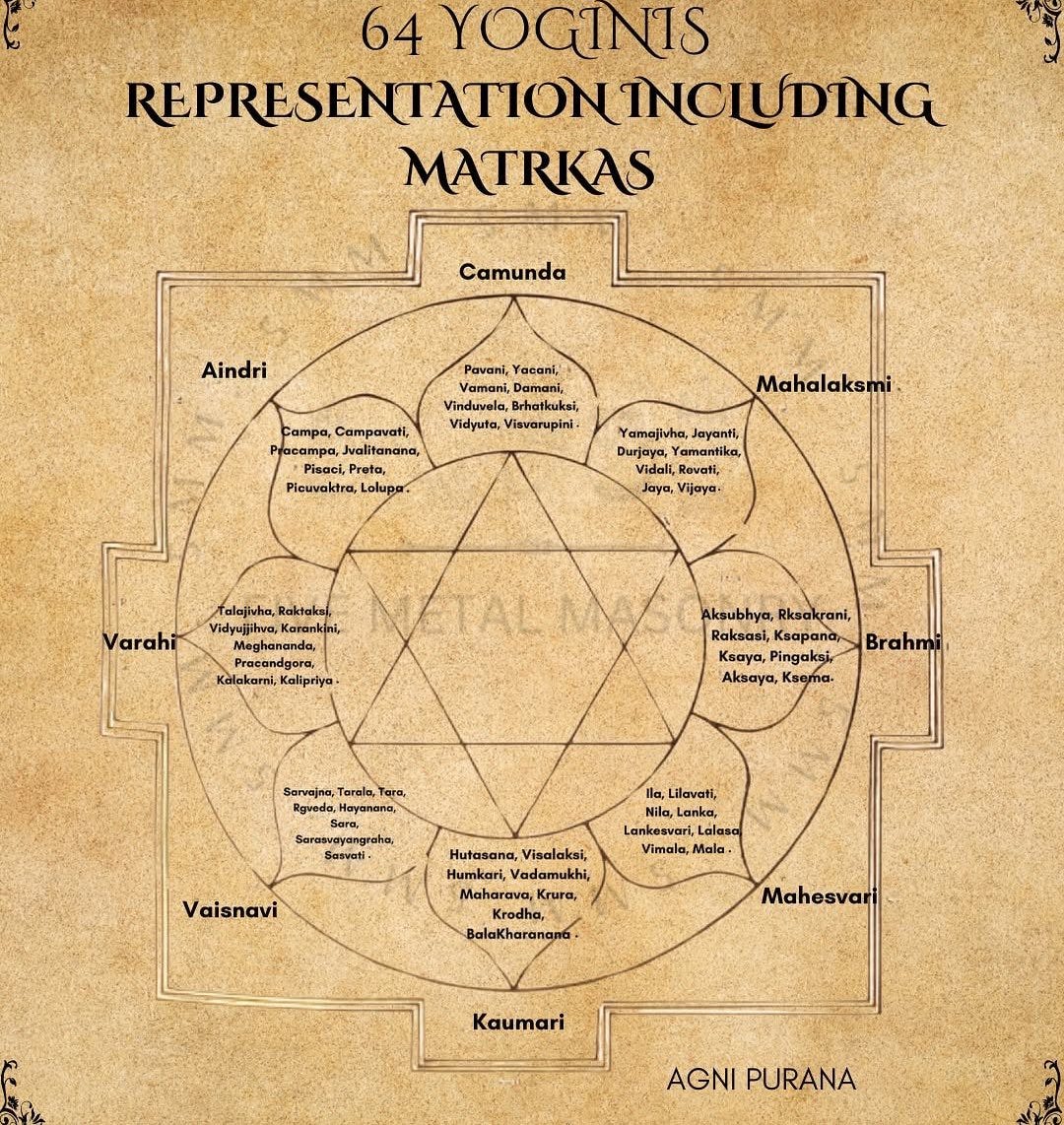🔱 The 64 Yoginīs: A Complete Exploration of Tantric Goddesses, Temples, Scriptures & Sculptures
The 64 Yoginīs (Catuḥṣaṣṭi Yoginī) represent one of the most esoteric and powerful traditions in Hindu Tantra, encompassing a complex tapestry of divine feminine energies (Śakti). Revered across regions, these Yoginīs appear in iconographic, ritual, and architectural forms spanning various Purāṇas and Tantric texts, and worshipped in hypaethral (roofless), circular temples across India.
This article offers a comprehensive synthesis of:
Directional Mandalas
Purāṇic listings (Skanda, Rudrayāmala, Kalika, Chandi, Mahākāla, Devi, Agni)
Temple architecture
Sculptural depictions
Tantric symbolism
🌸 The Yoginī Mandala: Directional Classification
One of the most recognizable visualizations of the 64 Yoginīs is the eight-directional mandala, where Yoginīs are arranged according to:
Cardinal and intercardinal directions
Color symbolism
Weapons or attributes
🔺 Directional Breakdown:
In the classical Yoginī mandala tradition, the 64 Yoginīs are arranged across the eight cardinal and intercardinal directions, each group bearing distinct symbolic attributes, colors, and weaponry:
North is associated with collyrium-hued (dark) Yoginīs, who wield sword, shield, and axe. The Yoginīs positioned here include Kesinī, Mālinī, Romajaṅghā, Kālī, and Adhomukhī.
North-East features smoke-hued Yoginīs, equipped with lance, iron club, and spear. Among them are Mundegardharinī, Kālīkā, Vyavalambinī, and Vyāghrī.
East is the direction of white-colored Yoginīs, holding trident (triśūla), drum (ḍamaru), noose (pāśa), and goad (aṅkuśa). These include Jayā, Ganeśvarī, Siddhayoginī, and Divyayoginī.
South-East hosts white-yellow Yoginīs bearing rosary, goad, gold, and book, symbolizing spiritual attainment and prosperity. This quadrant includes Preta, Śākinī, Vetālī, and Kumārī.
South is dominated by blood-red Yoginīs, armed with a spear and making the fear-dispelling gesture (abhaya mudrā). These fierce goddesses include Bhayāṅkarī, Kālapriyā, Vārāsī, and Virūpakṣī.
South-West is home to lightning-hued Yoginīs, equipped with banner, bow, arrow, and noose. Here we find Kāmeśvarī, Raktakālī, and Jvālāmukhī.
West is characterized by red-lotus-colored Yoginīs, who carry a pitcher, rosary, and show the abhaya gesture. Yoginīs of this direction include Dhunrākṣī, Mantrayoginī, and Dveśinī.
North-West features again smoke-hued Yoginīs, armed with conch (śaṅkha), discus (cakra), and club (gadā). This quadrant includes Kālinī, Yamadūtī, and Bhuvaneśvarī.
📖 Origin and Interpretations of Yoginī
Shrouded in mystery: No single consistent list across scriptures.
Emerge around the 8th century CE via Tantra.
The word Yoginī has multiple interpretations: sorceress, adept, deity, consort, acolyte, or divine attendant.
Interpretative Roles:
Adepts in Yoga
Sorceresses
Yoginīs of astrology, cakras, and Devi aspects
Attendants or Matrika allies
Patron goddesses of the Kaula Tantra tradition
🛕 Yoginī Temples: Sacred Circular Spaces
Yoginī temples break from traditional Indian temple architecture:
Circular layout, open to the sky (hypaethral)
No shikhara, garbhagriha, or inner sanctum
Built for tantric rituals, yantra-worship, and invoking cosmic energy
Notable Temples:
Caunsath Yoginī, Bheraghat (Madhya Pradesh) – Yoginīs seated in Lalitāsana
Hirapur (Odisha) – Yoginīs standing with their vahanas
Ranipur-Jharial (Odisha) – Yoginīs in dancing poses
Also at Khajuraho and Mitaoli (Madhya Pradesh)
📜 Canonical Yoginī Lists
🪔 1. Skanda Purana (Kasi Khanda)
A diverse mix of animal-headed, fierce, and esoteric Yoginīs.
Examples:
Gajanana (elephant-faced)
Pisacini (flesh-eater)
Lalajjihva (tongue hanging)
Kali, Garbha-bhaksa (foetus eater)
Vidyutprabha (lightning)
Kamaksi (eyes of love)
✅ Full list: 64 Yoginīs with vivid animalistic, cosmic, and fierce identities
🕯️ 2. Rudrayāmala Tantra
In the Rudrayāmala Tantra, the 64 Yoginīs are categorized into eight distinct groups, each containing eight Yoginīs. These groups are distinguished by body color, symbolic weaponry, and emotional or energetic expressions, reflecting the Tantric system’s emphasis on ritual aesthetics and layered spiritual symbolism.
The first group consists of golden-complexioned Yoginīs, radiating divine brilliance. These goddesses bear four arms and carry a trident (triśūla), sword (khaḍga), noose (pāśa), and a hand-drum (ḍamaru). Representative figures from this group include Mahesvarī and Dākinī.
The second group features white-bodied Yoginīs, adorned with ornaments and symbolic of purity and clarity. They hold a rosary (akṣamālā), goad (aṅkuśa), book (pustaka), and lute (vīṇā). Examples of this set include Kankālī and Rudra-vetālī.
The third group includes blue-complexioned Yoginīs, symbolizing fierce power and cosmic flame. These Yoginīs are armed with a flame (ivalā), a mace (gadā), and a lance (kunta). Notable members include Dhūmākṣī and Vīrabhadra.
The fourth group consists of smoke-grey Yoginīs, representing wrath and battle-readiness. They wield a sword, shield, spear, and battle-axe (paraśu). Yoginīs such as Tripurantakī and Caṇḍikā belong to this group.
The fifth group again comprises white-colored Yoginīs, but these are armed with a bludgeon (parigha) and short javelin (bhindipāla), giving them a more direct martial character. Included here are Muṇḍa-dhāriṇī and Mantra-yoginī.
The sixth group features reddish-yellow Yoginīs, with the same weapons as the fifth group. This group includes vibrant, intense forms like Kankālī and Kāmukī.
The seventh group is made up of red-bodied Yoginīs, symbolizing passion, potency, and blood-energy. They also bear the same weapons and include deities such as Lakṣmī, Kriyādūtī, and Saṁkhinī.
The eighth and final group consists of lightning-hued (tatit-prabhā) Yoginīs, dazzling in appearance and quick in energy. With similar armaments to the preceding groups, this set includes striking Yoginīs like Kāmukī-lolā, Kapālī, and Viṣa-bhojinī.
🔱 3. Chandi Purana
Reflects Odia tradition with emphasis on:
Local goddesses: Tarini, Ghatabari, Kachikeswari
Cosmic forms: Brahmayani, Rudrayani, Narayani
Diverse roles: Kamasena (passion), Dakeswari, Kalavati, Mohini
⚡ 4. Kalika Purana
Steeped in Assamese Tantra, connecting Yoginīs to:
Mahavidyas: Kali, Tara, Dhumavati, Kamakhya
Navadurgas: Chandika, Rudrani, Kausiki
Nature spirits: Sakambari, Narasimhi, Bhramari
🕊️ 5. Devi Purana
Spiritualized Yoginīs combining:
Qualities: Dhṛti (fortitude), Santi (peace), Yasa (fame)
Cosmic Mothers: Mahalakshmi, Mahamaya
Tantric Devi Avatars: Arundhati, Ghanta, Kheta, Jayavati
Feminine Mystique: Ratilalasa, Mohani, Kriya
🔥 6. Mahākāla Saṁhitā
A fierce, Tantric-oriented Yoginī pantheon:
Warrior forms: Narasimhi, Chamunda, Vidyutjihva
Esoteric: Meghamala, Suskodari, Svadha, Mahapreta
Mahavidya linkage: Tara, Kali, Rudrani, Candurupini
Yogic guides: Karalini, Aparna, Mahodari
🪷 7. Agni Purana: Mandala with Mātṛkās
The Yoginīs are arranged with eight Mātrikās at the petals:
Brahmi, Mahesvari, Kaumari, Vaisnavi, Varahi, Aindri, Camunda, Mahalakshmi
Each cluster includes Yoginīs like:
Vidyutā, Kṣema, Rkṣakrani, Suskarnī, Pavani, Yamojihva, etc.
This emphasizes the Shakta cosmology of eight-fold mothers presiding over the Yoginī pantheon.
📊 Comparative Overview: Yoginī Groupings Across Purāṇas
Across various Purāṇic and Tantric texts, the portrayal of the 64 Yoginīs varies widely—each text offering a distinct interpretation tailored to its theological, ritualistic, and regional context. In the Skanda Purāṇa, the Yoginīs are described with naturalistic and often fierce traits, many of them bearing animal heads. Examples include Gajananā, the elephant-faced; Simhamukhī, the lion-headed; and Papahantrī, known as the destroyer of sin.
In contrast, the Rudrayāmala Tantra offers a highly ritualized and symbolically rich classification. The Yoginīs are grouped by color and weaponry: golden-colored Yoginīs like Divyayoginī, red-hued forms like Lakṣmī, lightning-hued figures such as Kapālī, and smoke-grey beings like Tripurāntakī—all reflecting aspects of Tantric cosmology and yogic experience.
The Chandi Purāṇa, rooted in the cultural and spiritual traditions of Odisha, highlights Yoginīs that are deeply local in character yet cosmically significant. Figures like Charchikā, Tarinī, Ghatabarī, and Kachikesvarī coexist with fierce deities like Kapālī and mystical names like Samuhā, reflecting a maternal and warrior-like balance.
In the Kalika Purāṇa, the Yoginīs appear with unmistakable Tantric and Mahāvidyā influence. Their wild feminine energy is expressed through names such as Mahākālī, Durgā, Śiva, Ugracandā, Candīkā, and Camuṇḍā. These forms are fierce, wrathful, and transformative, drawing from cremation-ground symbolism and Shakta rituals.
The Devi Purāṇa presents a more yogic and psychological perspective, listing Yoginīs with names that represent virtues and internal powers. These include Dṛti (fortitude), Yasa (fame), Kriyā (action), Māyā (illusion), Ratilālasā (lustfulness), Sāntī (peace), and Matangī (a form of Sarasvatī), showing an inward, devotional, and spiritual orientation.
Finally, the Mahākāla Saṁhitā emphasizes ritual power, wrath, and the cremation-ground aesthetic of Tantra. Yoginīs here include Rudrāṇī, Vidyutjihvā (lightning-tongued), Meghamālā (cloud-garlanded), Rkṣakranī (bear-faced), and Mahāpretā (great ghost), representing transformational forces through fierce archetypes.
Each of these texts thus weaves its own tapestry of divine femininity, highlighting how the Yoginīs serve as portals into vastly different, yet interconnected, spiritual realms.
🧘♀️ The Yoginīs and the Eight Matrikās: Tantric Cosmology in the Agni Purana
A unique and symbolic representation of the 64 Yoginīs is found in the Agni Purana, where they are arranged around the Ashta Matrikās (Eight Divine Mothers). This reflects the mandala principle in Tantra—mapping spiritual energy in geometric formations.
🔶 The Eight Anchoring Matrikās:
Brahmī – Shakti of Brahma, wisdom and order
Maheshvarī – Shakti of Shiva, force and dissolution
Kaumārī – Shakti of Kumara/Skanda, youth and war
Vaiṣṇavī – Shakti of Vishnu, preservation and dharma
Vārāhī – Shakti of Varaha, protection and earth energy
Aindrī – Shakti of Indra, sovereignty and thunder
Cāmuṇḍā – Fierce form of Durga, slayer of demons
Mahālakṣmī – Goddess of wealth and abundance
Each Matrikā is surrounded by a subset of Yoginīs, bearing attributes like:
Pavani, Yacani, Vidyutā, Visarupiṇi
Rksakrani, Raksasi, Ksapanā
Durjaya, Yamantika, Rovati
Krodha, Mahārava, Krūra
This layout is deeply symbolic—used in yantra sādhanā, ritual mandalas, and temple architecture, where the Yoginīs form a protective and empowering perimeter.
🗿 Yoginīs in Sculpture: Artistic Veneration
Sculptural representations bring the textual and metaphysical descriptions of Yoginīs to life. From stone-carved niches in Odisha to elevated plinths in Madhya Pradesh, Yoginī figures are revered through form.
🪷 Characteristics of Yoginī Sculptures:
Animal-heads: Elephant, lion, owl, vulture, dog, cow, snake
Multiple arms: Symbolizing divine ability and superhuman power
Weapons: Sword, trident, dagger, discus, noose, skull
Postures: Seated (lalitāsana), dancing, standing, or dynamic action
Facial expressions: Often fierce, smiling, serene, or terrifying
Nudity/Semi-nudity: Emphasizing their detachment from societal norms and embodiment of primal energy
These sculptures are not decorative—they are invocational, protective, and experiential. Many are accompanied by their vahanas (mounts), aura circles, and mudras of boons or fearlessness.
🐘 Symbolism of Animal Heads and Divine Weapons
One of the most visually arresting features of the Yoginīs is their frequent depiction with animal heads. This is a powerful Tantric symbol, emphasizing their primal, cosmic, and non-human nature. These heads do not degrade their status but elevate them as beings who transcend mundane human categories.
For example, the elephant head seen on Gajananā symbolizes wisdom and the ability to remove obstacles. The owl, represented in Ulūlikā, suggests night vision, hidden knowledge, and spiritual alertness. The lion-headed Simhamukhī exudes raw ferocity and dominance, while Grdrasya, the vulture-headed Yoginī, signifies transcendence through death and decay.
Other forms include the crow-headed Kākutandikā, associated with omens and ancestral speech, and the camel-headed Uṣṭragīva, a symbol of endurance in spiritual deserts. The dog-headed Svanākara represents instinct and underworld navigation, while the snake-headed Sarpasya invokes kundalini energy and cyclical transformation. The deer-headed Mṛgāsīrsa speaks to transcendence, gentleness, and sensitivity.
Through these forms, Yoginīs reveal themselves as bridges between the human and the animal, the sacred and the wild, the conscious and the instinctual.
Their weapons, too, carry deep symbolism. The sword (khadga) cuts through illusion and brings clarity. The trident (trishula) represents the divine cycle of creation, maintenance, and destruction. The noose (pāśa) binds karma and controls spiritual forces, while the shield (kheta) protects against inner and outer threats.
The flame (ivalā) burns ignorance; the book (pustaka) contains sacred knowledge; the rosary (akṣamālā) is a tool for mantra recitation and spiritual discipline. The axe (parashu) severs attachment and ignorance, the goad (ankuśa) controls the senses, and the drum (ḍamaru) reverberates with cosmic rhythm.
Together, these attributes show that Yoginīs are not merely armed for battle—but for spiritual warfare against ignorance, delusion, and bondage.
🧬 Esoteric Symbolism: Yoginīs in Tantric Practice
Yoginīs are central to Tantric initiation (diksha), ritual worship (puja), and inner alchemy (sādhanā). Their depictions, mantras, and visualizations serve as portals into altered states of consciousness.
🔮 Key Tantric Themes:
Threshold Guardians: Yoginīs preside over the liminal zones between life, death, and rebirth.
Embodiments of Siddhis: Each Yoginī grants specific spiritual powers—clairvoyance, transformation, control over elements.
Liberators through Bhoga: They guide practitioners through desire (bhoga) toward liberation (moksha)—a hallmark of left-hand Tantra.
Sacred Geometry: Their arrangement in circles or petals represents the sacred mandala of existence, often used in Yantra worship.
🌺 Yoginīs in the Modern World: Revival, Feminism & Art
In the 21st century, the 64 Yoginīs are experiencing a dynamic resurgence—not only in temples and academic circles but also in feminist thought, artistic expression, and modern spiritual practice.
🧠 Academic and Spiritual Revival
Yoginīs are the subject of renewed interest in both Tantric studies and gender theology. Scholars such as Vidya Dehejia, David Kinsley, and Douglas Brooks have written extensively about their origins, symbolism, and worship. In psychology, Yoginīs are examined as archetypal energies that align with Jungian models of the feminine unconscious.
💃 Feminist Reclamation
Today, Yoginīs are embraced as icons of female autonomy and sacred wildness. They defy patriarchal norms by embodying assertiveness, rage, sensuality, wisdom, and freedom. Feminist spiritualists celebrate Yoginīs for breaking the mold of submissive goddesses and offering models for embodied empowerment.
🎨 Yoginīs in Art and Culture
Yoginīs now appear in museum exhibitions, contemporary art installations, documentaries, and even cinematic visual language. Their themes—such as shadow integration, desire-transcendence, and cyclical regeneration—resonate deeply with artists exploring the sacred feminine.
They have also influenced ritual theater, Tantric dance, and symbolic storytelling in modern spiritual communities.
🧘♀️ Yoginī-Inspired Movements
New-age movements and traditional lineages alike have launched Yoginī circles, women’s retreats, and eco-spiritual pilgrimages to Yoginī sites like Hirapur. These journeys emphasize spiritual awakening through body wisdom, sisterhood, and communion with elemental energies.
Festivals and workshops dedicated to Shakti Tantra often invoke the Yoginīs in rituals that seek to harmonize the inner feminine with nature’s divine rhythms.
🗿 Sculptural Depictions: Artistic Echoes of Power
The stone sculptures from temples like Hirapur and Bheraghat reflect:
Animal heads: Cow, horse, elephant, owl, lion
Weapons: Sword, shield, dagger, skull
Postures: Seated (lalitāsana), dancing, standing with vahanas
Attributes: Nudity, wrath, grace, multiplicity of arms, third eyes
They reflect Tantric embodiment of the Yoginī’s power (siddhi), beauty (saundarya), and mystery (māyā).
The Yoginī Cosmos
The 64 Yoginīs are more than goddesses—they are:
Embodied energies of Devi
Ritual guides in Yogic, Tantric sādhanā
Cosmic archetypes blending fear, wisdom, love, rage
Protective and initiatory forces in both internal and external temples
Their sacred geography, ritual presence, and textual richness continue to inspire devotion, scholarship, and spiritual practice even today.
The 64 Yoginīs are not merely mythological figures—they are living, breathing symbols of the cosmos, the psyche, nature, and divine feminine power. They represent the paradoxes of life: fierce yet nurturing, wild yet wise, erotic yet transcendent.
Through temple carvings, scriptural references, and visual meditations, they continue to offer guidance, protection, and insight to those brave enough to walk the Tantric path.
They are teachers of:
Liberation beyond fear
Sacred embodiment
Tantric wisdom of opposites
Unity between the primal and the divine
In the flicker of a lamp, the beat of a drum, the whisper of wind, and every courageous act of feminine sovereignty—the Yoginīs dance eternally in a circle without end.


